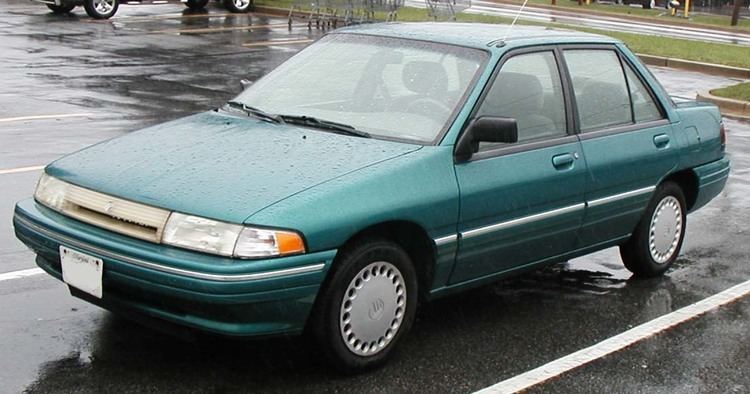Production 1987–1989, 1990–1999 | Layout FF layout | |
 | ||
The Mercury Tracer is a compact car that was marketed by Mercury from 1987 for the 1988 model year until 1999. The replacement for the Ford Escort-derived Lynx, the first generation of the Tracer was a modified version of the Asia-Pacific market Ford Laser, itself a variant of the Mazda 323. In 1990 for the 1991 model year, the Tracer became the Mercury counterpart of the Ford Escort in North America. All three generations of the Tracer were based on variations of the Mazda 323/Protegé.
Contents
- First generation 19881989
- Engine
- Second generation 19911996
- Engines
- Trim levels
- Third generation 19971999
- Proposed 2011 revival
- References
The Ford Focus would serve as a common replacement for both the Ford Escort and the Mercury Tracer.
First generation (1988–1989)
The Tracer was introduced in late 1987 as a 1988 model, replacing the Lynx in the United States and Canada. For the first time since the 1978 Capri II, the Mazda 323-based Tracer was a model unique to the Mercury division. Although derived from the Ford Laser sold in Asia and Australia, it was sold without a Ford counterpart in North America. As with its predecessor, the Tracer was sold in three-door and five-door hatchback body styles along with a five-door station wagon. The Tracer hatchback shared its body shell with the Ford Laser; while the station wagon was based loosely on the five-door hatchback, it was a distinct design.
The Mercury Tracer was assembled in a number of production facilities; the location was dependent on the body style and the country to which it was exported. Three-door hatchbacks for the US market were built alongside the Mazda 323 in Hiroshima, Japan, while five-door models were built in Mexico by Hermosillo Stamping & Assembly, where all station wagons were produced. For the Canadian market, both three and five-door hatchback models were built in Taiwan by Ford Lio Ho.
Engine
Second generation (1991–1996)
After skipping the 1990 model year, the Tracer returned in early 1990 as a 1991 model. While again based on the Mazda B platform, it now shared a body with the Ford Escort and the Mazda Protegé. The hatchback models were replaced by a four-door sedan; the five-door station wagon was carried over. The Tracer was sold in three trim levels: GS, LS, and LTS. The LTS was discontinued in 1993.
Changes to the Tracer over this generation were relatively few. In 1992, the plastic grille insert was replaced by the light bar grille seen on the Topaz and Sable. In 1993, a driver's side airbag replaced the automatic seatbelts; in 1994, a passenger airbag was added, bringing a redesigned dashboard with it.
The Tracer LTS (which used the more powerful 1.8L Mazda engine shared with the Escort LX-E and Escort GT) was named to Car and Driver magazine's Ten Best list for 1991.
Engines
Trim levels
Sedan
Wagon
Third generation (1997–1999)
The Tracer and Escort were updated in 1996 for year model 1997 with a redesigned exterior and interior, and a new engine. The platform remained the same as before.
The Tracer wagon largely retained the same body style, gaining only the new interior, front end & fascia, side-view mirrors, door handles, badging, and slightly restyled taillamps and reflectors.
In addition to GS and LS trims, there was also a Trio appearance package offered from model year 1997 until 1999 on the GS. The LS trim featured tachometers and alloy wheels along with optional leather interior, key-less entry and power windows and door locks.
All Tracer models were discontinued in 1999 along with the Escort wagon. Mercury sold 23,146 Tracers in its last model year. The final Mercury Tracer rolled off the assembly line on July 2, 1999.
Trim levels
Sedan
Wagon
Engines
Proposed 2011 revival
Early in 2010, the Tracer nameplate nearly made its return to the Mercury model lineup. As Ford confirmed its 2012 model line with dealers, the Mercury model line was expanded with an all-new compact sedan slotted below the mid-size Milan. Reviving the Tracer nameplate for the first time in 13 years, the new sedan would be based on the 2012 Ford Focus, giving the Mercury division a version of the Focus for the first time.
However, in the summer of 2010, the Mercury division was phased out, leaving the proposed Tracer to be cancelled.
